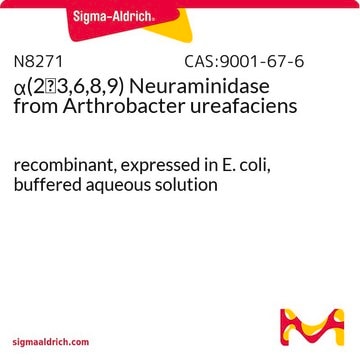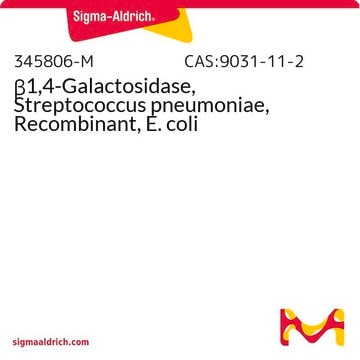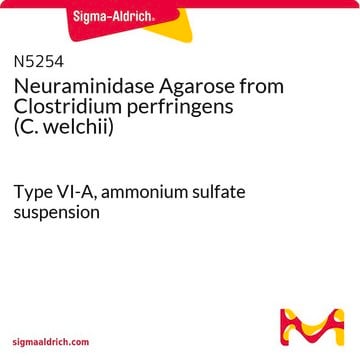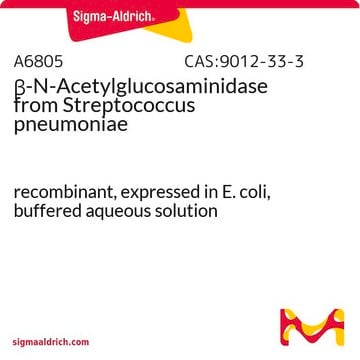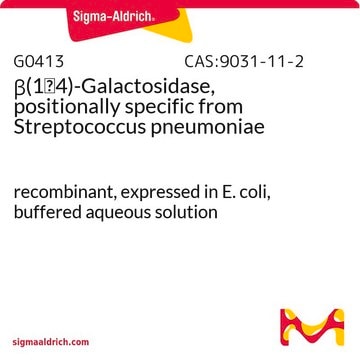It is shipped at ambient temperature, but it is to be stored at 2-8 °C for long term storage. Do not FREEZE as it is in a buffered aqueous solution.
N7271
α(2→3) Neuraminidase from Streptococcus pneumoniae
buffered aqueous solution
Sinónimos:
Acyl-neuraminyl Hydrolase, Acylneuraminyl hydrolase, Receptor-destroying enzyme, Sialidase
About This Item
Productos recomendados
origen biológico
Streptococcus pneumoniae
Nivel de calidad
Formulario
buffered aqueous solution
concentración
≥5 units/mL
actividad extraña
β-Galactosidase, α-mannosidase, β-hexosaminidase, α-fucosidase, and proteases, none detected
Condiciones de envío
wet ice
temp. de almacenamiento
2-8°C
Información sobre el gen
Streptococcus pneumoniae R6 ... nanB(933504)
Categorías relacionadas
Acciones bioquímicas o fisiológicas
Envase
Definición de unidad
Forma física
Nota de preparación
Palabra de señalización
Danger
Frases de peligro
Consejos de prudencia
Clasificaciones de peligro
Resp. Sens. 1
Código de clase de almacenamiento
13 - Non Combustible Solids
Clase de riesgo para el agua (WGK)
WGK 1
Punto de inflamabilidad (°F)
Not applicable
Punto de inflamabilidad (°C)
Not applicable
Equipo de protección personal
Eyeshields, Gloves, type N95 (US)
Elija entre una de las versiones más recientes:
¿Ya tiene este producto?
Encuentre la documentación para los productos que ha comprado recientemente en la Biblioteca de documentos.
Los clientes también vieron
Artículos
Understand sialic acid structure, function, signaling, and modifications. Easily find products for sialic acid research.
-
What is the long term storage and shipping condition of ?(2—›3) Neuraminidase, Product No. N7271?
1 answer-
Helpful?
-
-
What is the molecular weight of ?(2—›3) Neuraminidase, Product No. N7271?
1 answer-
The molecular weight of this ?(2—›3 Neuraminidase enzyme is approximately 75 kDa.
Helpful?
-
-
What is the Department of Transportation shipping information for this product?
1 answer-
Transportation information can be found in Section 14 of the product's (M)SDS.To access the shipping information for this material, use the link on the product detail page for the product.
Helpful?
-
-
For ?(2—›3) Neuraminidase, Product No. N7271, what is the optimum pH range for the neuraminidase enzyme activity?
1 answer-
The optimum pH range for ?(2—›3 neuraminidase is 6.0. Please see the data sheet.
Helpful?
-
-
What are the reaction conditions of the enzyme ?(2—›3) Neuraminidase, Product No. N7271?
1 answer-
One nanomole of substrate or less can be cleaved in a 20 μL reaction volume. In the standard reaction use: 4 μL of 5X enzyme reaction "buffer B" (=250 mM sodium phosphate buffer, pH 6.0), a combined volume of 14 μL containing purified oligosaccharide and water and 2 μL of NANase I (N7271). Incubate 1 hour at 37 °C. To cleave more than one nanomole of substrate, increase reaction volume and enzyme proportionally.
Helpful?
-
Active Filters
Nuestro equipo de científicos tiene experiencia en todas las áreas de investigación: Ciencias de la vida, Ciencia de los materiales, Síntesis química, Cromatografía, Analítica y muchas otras.
Póngase en contacto con el Servicio técnico


